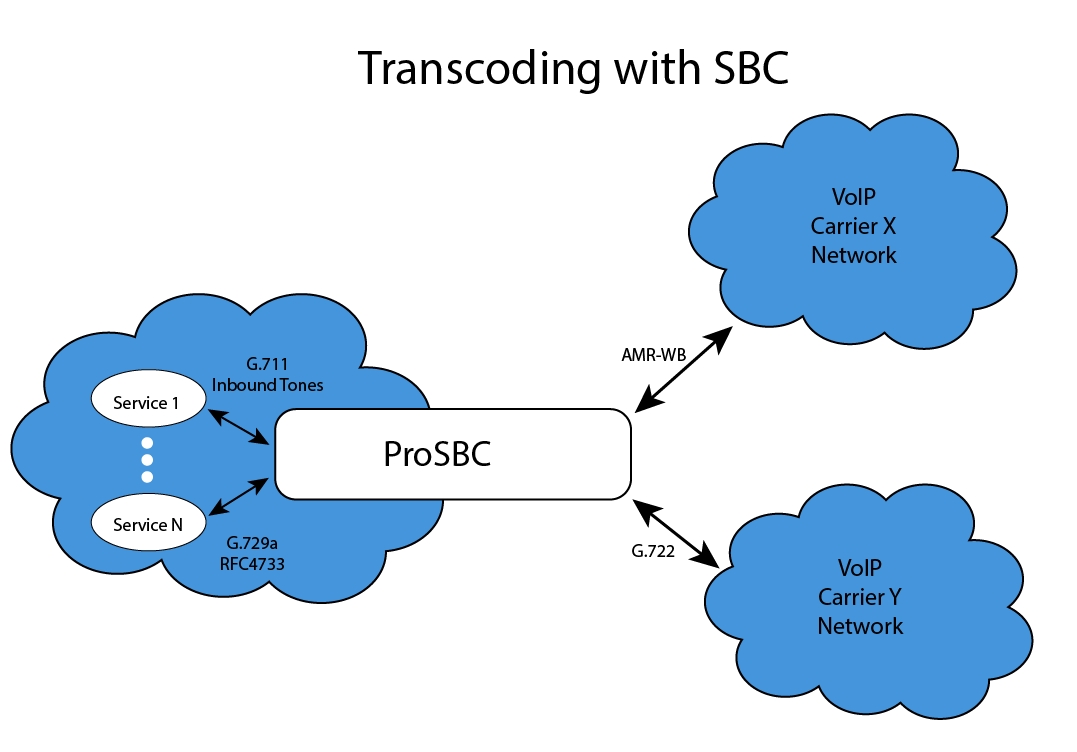Transcoding
Transcoding Solutions
The migration from traditional networks to IP core networks has simplified the overall deployment overhead involved with physical equipment interoperability, but it has not reduced the challenges in making these devices understand each other. Signaling compatibility is certainly one of these challenges, but it is also very close to media compatibility, when it comes to making diverse vendor equipment and networks communicate with each other. TelcoBridges transcoding solutions are designed to overcome these challenges in IP networks by offering a wide range of vocoders packed with extensive signaling transcoding capabilities. This ideal combination offers the most efficient solution to fulfill transcoding needs for carriers, operators and enterprises while keeping CAPEX and OPEX within budget without sacrificing agility or rapid deployment.

IP network adaptation
Whether TelcoBridges solutions are required to resolve signaling or complex media stream transcoding, or all of these at the same time, the state-of-the-art architecture and hardware technology of the ProSBC Session Border Controller can tackle these challenges head-on. With a vast list of supported vocoders for wireline, wireless and high-definition media streams, the solution can address all possible transcoding needs. The embedded resource optimization engine included in these solutions dynamically ensures transcoding capabilities are used only when necessary to maximize the system throughput.
Rapid and ease of deployments
Deploying transcoding solutions to bridge devices and networks should be a painless and straightforward process for operators, carriers and enterprises. To guarantee this, TelcoBridges solutions offer multiple provisioning and monitoring interfaces for fast integration into existing network infrastructures. From legacy console configuration to RESTful API programmatic and web interface, the SBC access interfaces satisfy all operation personnel from IT network managers and on-site technicians, to Network Operations Center (NOC) engineers. Less time spent managing a network means more time to invest in delivering innovative end-customer services.
Carrier Grade
TelcoBridges solutions all benefit from a decade of experience in building and deploying always-on services with the highest industry standards for reliability and up-time. Targeted to carriers, operators and large enterprises around the world, TelcoBridges’ carrier grade portfolio is designed to be a worry-free experience. TelcoBridges is proud to have deployed highly available equipment in more than 100 countries around the world.
Cost effectiveness
Budget is always a key consideration when introducing a transcoding solution into a network. TelcoBridges’ scalable approach for transcoding media resources ensures the initial capital expense addresses not only what is required to start a project, but also allows for an adjustment of those needs down the road when the traffic grows and evolves. TelcoBridges’ transcoding solutions provide a fast Return-On-Investment (ROI) to help get more traction with new services and deployments.
Software Transcoding Capacity
G.711 alaw <-> G.711 ulaw
All sessions
Configurations
Hardware Transcoding Capacity
G.711 DTMF in-band <-> G.711 RFC 2833
1372
2744
G.711 fax passthrough <-> T.38
740
1480
G.711 <-> G.723.1
740
1480
G.711 <-> G.729ab
848
1696
G.711 <-> AMR-NB
574
1148
G.711 <-> AMR-WB
404
808
G.711 <-> G.722
404
808
G.711 <-> iLBC
494
988
ProSBC Session Border Controller is ideal for transcoding needs.
Configurations
For ProSBC Hardware Transcoding, you need to purchase the hardware and install this in your central office. The network setup is described here:
FAQs
Can we connect to ProSBC directly together for High availability control?
When using ProSBC in a 1+1 architecture, you need two interfaces for redundancy, called ctrl0 and ctrl1. These interfaces can be connected directly between the servers (or virtual machines). If you are using a transcoding device, it is not possible to connect them directly as these interfaces will also be used to control the transcoding devices. They need to be on a private network between the ProSBC controllers and the transcoding devices. On the transcoding device they are called eth0/eth1 (instead of ctrl0/ctrl1) Which interfaces are required for ProSBC? NIC = Ethernet network interface
1. ProSBC in standalone mode One NIC for Management, One NIC for VoIP* (or Two NICs for separating the networks)
2. ProSBC in standalone mode with transcoder device One NIC for Management, One NIC for VoIP* (or Two NICs), Two NICs for transcoder RTP*, Two NICs for transcoder control ports
3. 1+1 ProSBC For each unit: One NIC for Management, One NIC for VoIP* (or Two NICs), Two NICs for control ports
4. 1+1 ProSBC with transcoder For Each unit: One NIC for Management, One NIC for VoIP* (or Two NICs), Two NICs for transcoder RTP*, Two NICs for transcoder control ports
Note (*): NIC for VoIP and transcoder RTP must be in the list of approved NIC cards, for example I350-T4 interfaces.
References
Last updated
Was this helpful?
